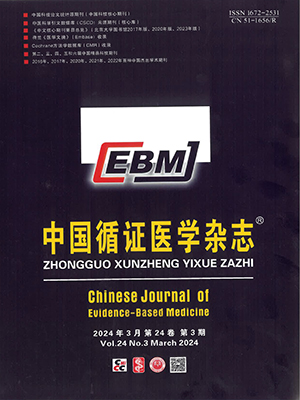| 1. |
Alonso-Coello P, Schünemann HJ, Moberg J, et al. GRADE Evidence to Decision (EtD) frameworks: a systematic and transparent approach to making well informed healthcare choices. 1: Introduction. BMJ, 2016, 353: i2016.
|
| 2. |
国家卫生健康委员会. 药品临床综合评价管理指南. 2021.
|
| 3. |
Kantorová L, Friessová T, Slezáková S, et al. Addressing challenges when applying GRADE to public health guidelines: a scoping review protocol and pilot analysis. Int J Environ Res Public Health, 2022, 19(2): 992.
|
| 4. |
孙铭谣, 田晨, 李颖, 等. 药物治疗新型冠状病毒感染快速动态循证要览. 中国循证医学杂志, 2023, 23(7): 745-754.
|
| 5. |
孙晓娥. 扎根理论在深度访谈研究中的实例探析. 西安交通大学学报(社会科学版), 2011, 31: 87-92.
|
| 6. |
Neumann I, Quiñelen E, Nahuelhual P, et al. Using Explicit Thresholds were valuable for judging benefits and harms in partially contextualized GRADE Guidelines. J Clin Epidemiol, 2022, 147: 69-75.
|
| 7. |
Helsingen LM, Zeng L, Siemieniuk RA, et al. Establishing thresholds for important benefits considering the harms of screening interventions. BMJ Open, 2020, 10(12): e037854.
|
| 8. |
Morgano GP, Mbuagbaw L, Santesso N, et al. Defining decision thresholds for judgments on health benefits and harms using the Grading of Recommendations Assessment, Development and Evaluation (GRADE) Evidence to Decision (EtD) frameworks: a protocol for a randomised methodological study (GRADE-THRESHOLD). BMJ Open, 2022, 12(3): e053246.
|
| 9. |
Hultcrantz M, Rind D, Akl EA, et al. The GRADE Working Group clarifies the construct of certainty of evidence. J Clin Epidemiol, 2017, 87: 4-13.
|
| 10. |
Zeng L, Brignardello-Petersen R, Guyatt G. When applying GRADE, how do we decide the target of certainty of evidence rating. Evid Based Ment Health, 2021, 24(3): 121-123.
|
| 11. |
Zeng L, Brignardello-Petersen R, Hultcrantz M, et al. GRADE guidelines 32: GRADE offers guidance on choosing targets of GRADE certainty of evidence ratings. J Clin Epidemiol, 2021, 137: 163-175.
|
| 12. |
Schünemann HJ, Neumann I, Hultcrantz M, et al. GRADE guidance 35: update on rating imprecision for assessing contextualized certainty of evidence and making decisions. J Clin Epidemiol, 2022, 150: 225-242.
|
| 13. |
Guyatt GH, Osoba D, Wu AW, et al. Methods to explain the clinical significance of health status measures. Mayo Clin Proc, 2002, 77(4): 371-383.
|
| 14. |
Qaseem A, Forland F, Macbeth F, et al. Guidelines International Network: toward international standards for clinical practice guidelines. Ann Intern Med, 2012, 156(7): 525-531.
|
| 15. |
ECBC. Evidence-based methodologies for public health. 2011.
|
| 16. |
WHO. WHO handbook for guideline development. 2012.
|
| 17. |
Schünemann HJ, Wiercioch W, Etxeandia I, et al. Guidelines 2.0: systematic development of a comprehensive checklist for a successful guideline enterprise. CMAJ, 2014, 186(3): E123-E142.
|
| 18. |
Williamson PR, Altman DG, Bagley H, et al. The COMET handbook: version 1. 0. Trials, 2017, 18(Suppl 3): 280.
|
| 19. |
Kirkham JJ, Davis K, Altman DG, et al. Core outcome set-standards for development: the COS-STAD recommendations. PLoS Med, 2017, 14(11): e1002447.
|
| 20. |
WHO. WHO handbook of guideline development (2nd edition). 2014.
|
| 21. |
丁泓帆, 杨楠, 邓围, 等. WHO指南制定的基本原则和方法. 中国循证医学杂志, 2016, 16(4): 471-477.
|
| 22. |
Schünemann H, Brożek J, Guyatt G, et al. GRADE handbook for selecting and rating the importance of outcomes (Updated October 2013). 2013.
|
| 23. |
Schünemann H, Brożek J, Guyatt G, et al. GRADE handbook for summarizing the evidence (Updated October 2013). 2013.
|
| 24. |
Shea BJ, Reeves BC, Wells G, et al. AMSTAR 2: a critical appraisal tool for systematic reviews that include randomised or non-randomised studies of healthcare interventions, or both. BMJ, 2017, 358: j4008.
|
| 25. |
陶欢, 杨乐天, 平安, 等. 随机或非随机防治性研究系统评价的质量评价工具AMSTAR 2解读. 中国循证医学杂志, 2018, 18(1): 101-108.
|
| 26. |
Higgins JPT, Thomas J, Chandler J, et al. Cochrane handbook for systematic reviews of interventions version 6.3 (updated February 2022). 2022.
|
| 27. |
Guyatt G, Oxman AD, Akl EA, et al. GRADE guidelines: 1. Introduction-GRADE evidence profiles and summary of findings tables. J Clin Epidemiol, 2011, 64(4): 383-394.
|
| 28. |
Siemieniuk RA, Bartoszko JJ, Zeraatkar D, et al. Drug treatments for COVID-19: living systematic review and network meta-analysis. BMJ, 2020, 370: m2980.
|
| 29. |
Guyatt GH, Oxman AD, Kunz R, et al. Going from evidence to recommendations. BMJ, 2008, 336(7652): 1049-1051.
|
| 30. |
Puhan MA, Singh S, Weiss CO, et al. A framework for organizing and selecting quantitative approaches for benefit-harm assessment. BMC Med Res Methodol, 2012, 12: 173.
|
| 31. |
Yu T, Fain K, Boyd CM, et al. Benefits and harms of roflumilast in moderate to severe COPD. Thorax, 2014, 69(7): 616-622.
|
| 32. |
Santesso N, Schünemann H, Blumenthal P, et al. World Health Organization guidelines: use of cryotherapy for cervical intraepithelial neoplasia. Int J Gynaecol Obstet, 2012, 118(2): 97-102.
|




